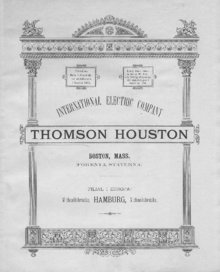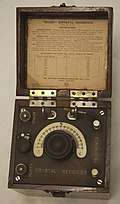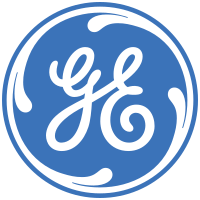Thomson-Houston Electric Company
The Thomson-Houston Electric Company was a manufacturing company which was one of the precursors of the General Electric company.

History
The Thomson-Houston Electric Company was formed in 1882[2] in the United States when a group of Lynn, Massachusetts, investors led by Charles A. Coffin bought out Elihu Thomson and Edwin Houston's American Electric Company from their New Britain, Connecticut, investors. The company moved its operations to a new building on Western Ave. in Lynn, Massachusetts, because many of the investors were shoe manufacturers from Lynn.[3]
Charles A. Coffin led the company and organized its finances, marketing, and sales operations. Elwin W. Rice organized the manufacturing facilities, and Elihu Thomson ran the Model Room which was a precursor to the industrial research lab. With their leadership, the company grew into an enterprise of $10 million in sales and 4000 employees by 1892.
In 1884 Thomson-Houston International Company was organized to promote international sales.
In 1888 Thomson-Houston supplied the Lynn and Boston Street Railway with the generation and propulsion equipment for the Highland Circuit in Lynn,[4][5] the first electric streetcar in Massachusetts.
In 1889 Thomson-Houston bought out the Brush Company (founded by Charles F. Brush) which resolved the arc lamp and dynamo patent disputes between them.
Thomson-Houston was later merged with the Edison General Electric Company of Schenectady, New York (arranged by J. P. Morgan), to form the General Electric Company in 1892, with plants in Lynn and Schenectady, both of which remain to this day as the two original GE factories.
International companies
British Thomson-Houston

British Thomson-Houston (BTH) was created as a subsidiary of (American) General Electric in May 1896. It was previously known as Laing, Wharton, and Down which was founded in 1886.
BTH became part of Associated Electrical Industries (AEI) in 1928, which saw BTH merged with its rival Metropolitan-Vickers. This deal made AEI the largest military contractor of the British Empire during the '30s and the '40s, so during World War II AEI would itself be acquired by the General Electric Company plc or GEC in 1967. GEC demerged its defense businesses in 1999 to become Marconi plc and Marconi Corporation plc, now Telent plc.
Compagnie Française Thomson-Houston
In 1893, the Compagnie Française Thomson-Houston (CFTH) was formed in Paris, a sister company to GE in the United States. It is from this company that the modern Thomson Group would evolve; demerged in 1999 to form Thomson Multimedia and Thomson-CSF (now Thales Group).
References and sources
- References
- The Utilisation Of The Electric Light, English Mechanics and the World of Science, Volume 26, Oct. 12, 1877, page 106
- "Elihu Thomson Papers, 1853-1955". Smithsonian Institution. July 23, 2014. Retrieved October 19, 2019.
in 1882, founded one of the early electrical corporations in the United States, the Thomson-Houston Company
- "Elihu Thomson Papers". Retrieved October 19, 2019. Elihu Thomson Papers at the American Philosophical Society
- The Thomson-Houston Road at Lynn, Mass., The Electrical World, Dec. 8, 1888, page 303
- Electric Railway at Lynn, Mass., Electric Power, January, 1889, page 21
- Sources
- Hammond, John Winthrop. Men and Volts, the Story of General Electric published 1941. 436 pages.
- Carlson, W. Bernard. Innovation as a Social Process: Elihu Thomson and the Rise of General Electric, 1870-1900 (Cambridge: Cambridge University Press, 1991).
- Woodbury, David O. Elihu Thomson, Beloved Scientist (Boston: Museum of Science, 1944)
- Haney, John L. The Elihu Thomson Collection American Philosophical Society Yearbook 1944.
_5.jpg)
